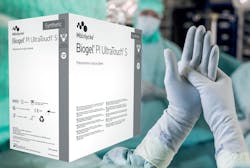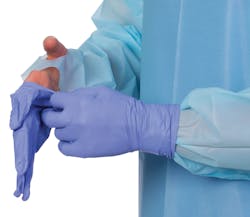Constructing an effective glove chain to outrace spiking demand, usage
As a member of the personal protective equipment (PPE) family and a critical component of standard or universal precautions since the 1980s, gloves have experienced the same surge capacity challenges as other PPE components during the two-year-plus pandemic.
Gloves previously sank into backorder and shortage status during the emergence of HIV in the 1980s, followed by the rise of needlestick and sharps injuries during the 1990s.
For healthcare workers trying to protect themselves and their patients from exposure to infection(s) through the prudent use of gloves, ample provisioning remains necessary.
As healthcare professionals and organizations continue to navigate and negotiate around and through a pandemic response, this latest crisis – the third major one in as many decades – should serve as a clarion call to arms.
When it comes to manufacturing, distributing, storing, using and disposing of gloves, have healthcare professionals and organizations demonstrated progress in the stewardship of these critical product staples? Glove manufacturers and supply chain experts recognize and acknowledge progress, but emphasize that room for improvement remains.
In the wake of whipsawing
As the pandemic continues to linger like the persistent cough following a bout with pneumonia, healthcare supply chain executives and professionals, leaders and managers, scramble to assess, evaluate and take stock of lessons learned to be prepared for … the next time.
Think of supply chain during a crisis or disaster as a cross between Murphy’s Law and Catch-22: If anything can go wrong it will as you deal with a dilemma from which you cannot escape or recover due to mutually conflicting or dependent conditions. In other words, a famished snake coiling to devour its own tail serves as a veritable pain in the asp.
“While the COVID-19 global pandemic saw a truly one-time unprecedented surge in demand and stockpiling that was well greater than the global manufacturing output and required re-scaling, the industry itself has been relentlessly tasked with generating cost savings that has come at the cost of contingency preparedness,” Lewis observed. “Such drive for continuous price savings over the decades eventually compromised manufacturing diversification, as well as the ability for suppliers to carry substantial buffer stock given the sharply reduced margins and cost aversion when managing truly global supply chains to ensure business sustainability.”
As a privately owned supplier of gloves and PPE for more than three decades, Tronex Healthcare committed to an inventory planning model that includes a signification investment level in adequate buffer stock. According to Lewis, “this principle enabled us to operate throughout the COVID-19 global pandemic without having to reduce allocation to existing customers on examination gloves.”
Healthcare Purchasing News offered supply chain experts in manufacturing, distribution and contracting a list of seven probable causes for glove shortages that have occurred throughout the last few decades extending back to the 1980s with “other” as an option. [See the chart on next page for the choices.]
Chief among the leading causes was “supplier/vendor distribution challenges (e.g., storage; transportation via air, land and sea).
No. 2 points to “Behavioral/consumption patterns (e.g., copious use/overuse and waste from improper handling or use, etc.).”
“Increased usage during the pandemic was driven by anticipatory need,” Steele noted. “Stockpiling became a proactive measure for many providers but created supply issues for those that lacked space and/or the ability to maintain large inventories.”
Labor issues among suppliers of all shapes and sizes represent the next two.
“The unpredictable timing and duration of pandemic-related closures and disruptions further compounded the instability of an already fragile supply chain,” Steele indicated.
“When we look back at the challenges disrupting glove supply, we see that healthcare providers simply could not articulate the drivers of demand for their glove usage during the pandemic,” she said. “They just knew they needed significant amounts of product. Similar to the ‘burn rate calculator’ listed as an example for causes for supply chain challenges, we saw massive panic buys from customers in February and March of 2020, which drained onshore, available supply before allocation controls could be installed. This created a bullwhip effect for the supply chain that has been a challenge for the industry to recover from. Initially, demand was almost unlimited, but now, as supply has caught up, we see a saturated market. It’s still difficult to estimate when the stockpiles that have been built will bleed down enough for normal procurement patterns to resume.”
Consequently, Cardinal Health rolled out a model to mitigate the uncertainty that it calls the Collaborative Planning, Forecasting and Replenishment (CPFR) approach. Simply put, Squeo describes CPFR as:
seeking cooperative management of inventory through joint visibility and replenishment of products throughout the supply chain
sharing information between suppliers and customers in planning and satisfying customer demands through a supportive system
allowing for continuous updating of inventory and upcoming requirements, making the end-to-end supply chain process more efficient.
Although Meredith Fantom, Director of Marketing, Exam Gloves division, Medline Industries, proffers a clear ranking of probable causes to glove supply chain challenges, she recognizes that the hierarchy of needs may be a bit more interwoven and less demarcated.
“As the access to raw materials over the past few decades has remained consistent, supplier and distributor challenges with logistics of finished products remain a challenge,” Fantom noted. “Unlike many suppliers and distributors, Medline operates a network of national distribution centers and a fleet of trucks that enable our company to easily move medical supplies across the country and often deliver within 24 hours.”
Investment in information technology helped make a difference, according to Fantom.
“Within Medline’s supply chain network, information technology upgrades that enhance visibility and tracking provide transparency into how our customer’s products are moving through our system and combine with the efforts of our onsite analysts embedded within our customer’s organizations to offer an unparalleled understanding of inventory needs, consumption and resupply status,” she said. “In smaller organizations, we have partnered with organizations like Hybrent to help our customers access some of the value our onsite analysts offer by providing visibility into existing inventory, supplies on order and previous orders as well as the ability to order from all vendors in one place.
“From our perspective, the lack of visibility into the supply chain exacerbates supplier and vendor distribution challenges, making these two aspects of the healthcare supply chain the most vulnerable, especially for facilities in need of gloves and PPE in the era of COVID,” she added.
But that’s not the leading culprit behind the glove supply chain challenges, Fantom asserts.
The No. 1 issue disrupting glove supply is behavioral and consumption patterns,” she insisted. “Frequently, facilities order a variety of gloves from various vendors in a variety of sizes without really taking a look at what they use, who is using them and where they are being used. Some facilities and organizations don’t have a good handle on whose ordering gloves, the cost of ordering, or what role the glove plays in care delivery.
To illustrate this point, consider a multi-location health facility that is ordering gloves in a decentralized manner with each location ordering a different type of glove, from a different vendor, in different sizes,” Fantom explained. “Because they are not aggregating their order, they are not able to access the best pricing versus buying one bulk order from one vendor. If each location is ordering a different size or brand versus standardizing, they are introducing variances in care delivery and increasing costs.
“This is also where understanding your facility’s consumption comes into play,” she continued. “If your facility is ordering multiple brands and sizes but using one size or brand more often, eliminating smaller sizes or underused brands could be a cost-saving option that also opens up more room for the inventory of supplies that are more critical to operations. Finally, depending on who is placing the order and if the facility’s individual locations are on your GPO roster, you may be missing out on additional cost savings by finding tiered pricing offered by your GPO.”
“The COVID-19 pandemic illuminated our nation’s overreliance on international gloves manufacturers - particularly with production of the bulk of the world’s supply concentrated in a single region,” Willink said. “Since early 2020, demand for gloves increased dramatically while at the same time, COVID lockdowns and geopolitical issues drove a massive shortfall in supply. In fact, via a January 2021 survey, Premier members cited access to exam gloves as the No. 2 greatest challenge to care for COVID-19 patients after clinical staffing.”
The aftershocks spiraled out from there.
“Challenges to accessing gloves were compounded by massive shipping delays, increased lead times and container shortages, all of which contributed to unprecedented supply shortages and pricing levels,” he continued. “The spike in demand also temporarily led to raw materials scarcity, creating shortages up the supply chain. All of these issues provided an avenue for bad actors with counterfeit products to enter the market.”
Premier estimates that glove demand globally has exceeded production capacity by nearly 40 percent since the beginning of the pandemic.
Riding the waves like a pro, not hodad
Finding useful and reliable solutions to pandemic-driven and related supply chain problems has been priority No. 1 during the last two years. While everyone may not agree universally on any single option, they generally agree that competition should take a back seat to customer service and communication should conquer confusion.
“The most impactful method to best mitigate supply crises in this ever-changing world is the transparency and partnership between customers and suppliers to create meaningful value,” insisted Tronex’s Lewis. “There must be a true spirit of partnership to understand the nature of manufacturing lead times, manufacturing diversification, buffer stock, change in usage patterns and clarity of information passed between each partner to ensure preparedness and contingency planning, particularly how such aspects impact what is sustainable financially. This is especially true when it comes to gloves and disposable PPE in general.”
HPN also offered supply chain experts in manufacturing, distribution and contracting a list of seven potential solutions for preventing, if not alleviating glove shortages that occurred throughout the last few decades extending back to the 1980s with “other” as an option. [See the chart on page X for the choices.]
Leading the charge? More effective and efficient use of IT (e.g., for tracking and tracing comprehensive sourcing and consumption/usage data via product data standards adoption and implementation; discovering counterfeit products).
Steele emphasizes that “efficient and accurate communication around manufacturers’ on-hand and available inventory and/or allocated quantities for a specific provider” will make a difference.
Nearshoring production/sourcing opportunities (relying on suppliers/vendors in an adjacent/bordering country) came next.
“Healthcare providers need manufacturers to keep costs down while at the same time improving access to available product,” Steele said. “With nearshoring and onshoring, manufacturers and suppliers can create additional points of production and storage of finished goods without having to navigate international waters.”
But Steele acknowledges the challenges with onshoring production/sourcing opportunities (relying on suppliers/vendors that return manufacturing/distribution services back to the country from which they originated), which was third.
“While onshore production might be costly and still highly reliant on international-based raw materials, the act of onshoring and using a third-party logistics company for storage of stockpiled finished goods could provide an improvement over previous sourcing methods,” she noted.
Switching manufacturers, distributors or group purchasing organizations (GPOs) for contracting and other services was listed fourth, but Steele expresses concern about that option.
“Assuming inventory allows, this is a reactive measure to dealing with supply bottlenecks,” she noted. “[Another] suggestion would be to dedicate 15%-20% of purchases to a domestic alternative to provide additional supply resiliency.”
Domestic production/sourcing opportunities only was one of the early pandemic recommendations but only reaches No. 5 now in hindsight.
“Assuming the availability of raw materials and cost equivalent labor/production, this is a viable solution to create redundancy and resiliency in the supply chain,” Steele added.
Nearing the bottom? What most everyone ended up doing: Backordering and hoarding when and where possible.
“Third-party logistics companies and/or provider consortiums built around pandemic stock might offer a way to improve resiliency while mitigating cost and risk or obsolescence/expiration,” Steele advised. “This solution doesn’t come without additional challenges, however. According to a Health Industry Distributors Association (HIDA) whitepaper from July 2020, it’s estimated it would take 13-15 tractor trailers to fulfil a 90-day stockpile of assorted supplies for a 350-bed facility.”
At the bottom, largely due to the amount of effort, planning and investment? Hospitals and health systems investing in/setting up their own manufacturing and/or distribution companies to serve themselves/each other.
“This solution is largely scale-dependent for offsetting production cost,” Steele said.
Still, Mölnlycke’s Schmid emphasizes the fundamentals as top priority, urging the “standardization and streamlining of glove suppliers and selection and the increase of safety stock across all steps of distribution – hospital, distributor, supplier, factory.”
Cardinal Health’s Squeo offers a trio of tips to keep providers on track for supply availability.
The first? “Utilizing an effective inventory planning and storage strategy – for daily and long-term needs – with a supply chain partner that can help a facility cycle through product to minimize expiration risk,” she said.
Next up: Renew, if not rebuild trust but recognize the cost for domestic production.
“While bringing manufacturing to the U.S. will help mitigate the issue, consider that in addition to the Chinese government shutting down exports, the U.S. also repatriated supply,” Squeo said. “What will be the determining factors for the countries or regions of the world considered a safe, reliable partner when a crisis of COVID’s global magnitude hits? Even within the U.S. borders, we saw states competing for access to supply and willing to venture into the grey market to build stockpiles.
Third, never underestimate the value of data.
“More effective supply chain data will enable better projected supply health,” Squeo insisted. “For example, during the pandemic, when the ports began to back up and constrain product on the water, our planning teams were forced to estimate goods receipt and transit times to replenish customers. The limits of transparency, tracking and information created frustration in an already challenged supply chain. At Cardinal Health, we’re continuously looking at ways to improve our planning processes to better meet the needs of providers.”
That’s why Cardinal Health has been investing in inventory management tools, such as Kinaxis, to help navigate challenges and plan more efficiently, according to Squeo. “It may take some time, but we made this decision to ensure our customers experience benefits directly, including:
- “Concurrent planning with end-to-end visibility factoring in seasonality and pandemic planning and the ability to easily identify material constraints and viable alternatives
- “Instant demand and supply balancing that factors in capacity
- “The ability to simulate any scenario in seconds, expediting the process of distributing service issue alerts offering potential solutions.”
- Medline takes a hands-on consultative role in working with provider customers, according to Fantom.
“Medline helps its customers make the most effective and efficient use of their supplies, including gloves, by partnering with organizations to enable better tracking, efficient ordering, and usage monitoring,” she said. “To achieve this, we partner with all levels of our [customer’s] organization to understand where improvements can be made. This takes the form of cross-functional groups, onsite surveys and physician preference groups that examine how products are selected, ordered and used to find ways of eliminating variance, standardizing practice and ensuring the proper glove is used by department and by task.”
Through its Glove Management Program (GMP) Medline can record and advise provider customers on exam glove consumption patterns.
“Through this we are able to objectively monitor a facilities glove usage, consolidate skus, reduce product waste, and ensure proper utilization for infection prevention protocols along with any necessary chemical protection,” she said. “Once this initial step is taken, we work with our GPO partners and internal teams to find opportunities for our customers to switch vendors and access tiered pricing offered through GPO contracts. In our experience, collaborating with a partner like Medline enables healthcare organizations the best option to mitigate risk and increase operational efficiency without losing focus on their core goal – delivering the best patient care.”
“Ensuring reliable access to gloves requires a multifaceted strategy,” he insisted. “On the supply side, we must reduce our dependance on overseas manufacturing. Bringing back domestic/near-shore production and having greater diversity of supply sources would provide a more resilient supply chain. For these critical products, we believe there should be three or more global suppliers and at least one U.S.-based source readily available to serve the American people. Our broad base of qualified supplier partners allowed us to leverage available monthly capacity with multi-sources.” [Editor’s Note: Premier has been working with Honeywell as one of its glove supplier partners since July 2021. Honeywell did not respond to repeated HPN requests for comment.]
“Additionally, providers and other consumers have been implementing glove conservation practices and other precautionary measures with the goal of slowing demand and increasing product days on hand,” Willink continued. “This is an industry-wide issue, so switching providers or hoarding product will not solve the issue in the long run.”
Reference:
1. Politiek K. et.al. Systematic ‑review of cost of-illness studies in hand eczema. Contact Dermatitis 2016.
There’s more online!
“What might the future hold for gloves?”
“Pandemic re-cued, glove suppliers come to the rescue”
Probable causes of glove supply disruptions over the decades
Ranked by supply chain expert source opinions
1. Supplier/Vendor distribution challenges (e.g., storage; transportation via air, land and sea)
2. Behavioral/consumption patterns (e.g., copious use/overuse and waste from improper handling or use, etc.)
3. Labor issues among manufacturers
4. Labor issues among distributors, service/third-party logistics companies
5. Manufacturer access to raw materials
6. Information technology-related issues (e.g., tracking internal consumption patterns, using a “burn rate calculator,” etc.)
7. Availability of counterfeit products
8. Other, such as market consolidation and larger suppliers forcing smaller suppliers to absorb demand
Potential solutions to glove supply shortages
Ranked by supply chain expert source opinions
1. More effective and efficient use of IT (e.g., for tracking and tracing comprehensive sourcing and consumption/usage data via product data standards adoption and implementation; discovering counterfeit products)
2. Nearshoring production/sourcing opportunities (relying on suppliers/vendors in an adjacent/bordering country)
3. Onshoring production/sourcing opportunities (relying on suppliers/vendors that return manufacturing/distribution services back to the country from which they originated)
4. Switching manufacturers, distributors or GPOs (e.g., contracting)
5. Domestic production/sourcing opportunities only
6. Backordering and hoarding when and where possible
7. Hospitals and health systems investing in/setting up their own manufacturing and/or distribution companies to serve themselves/each other
8. Other, such as multiple manufacturer product line locations
Source: Healthcare Purchasing News, April 2022
About the Author
Rick Dana Barlow
Senior Editor
Rick Dana Barlow is Senior Editor for Healthcare Purchasing News, an Endeavor Business Media publication. He can be reached at [email protected].









